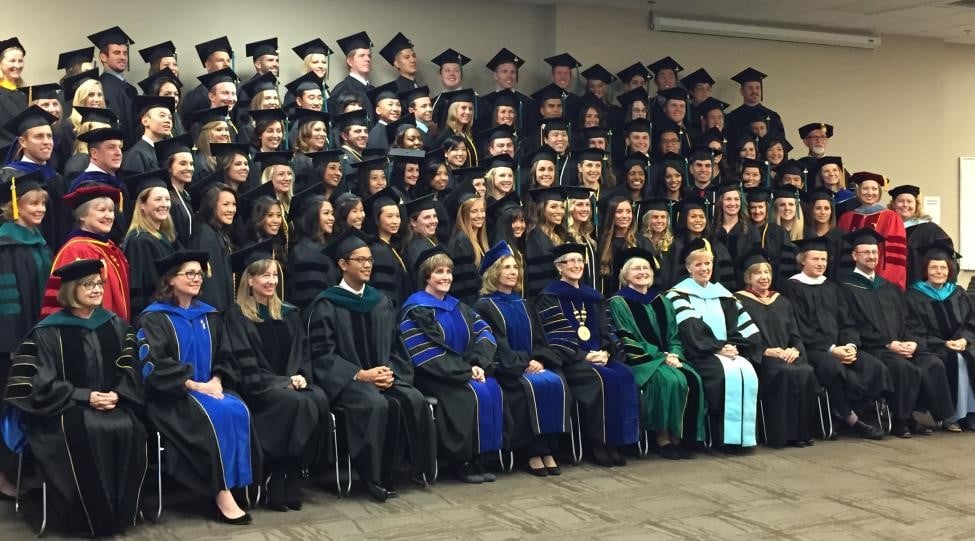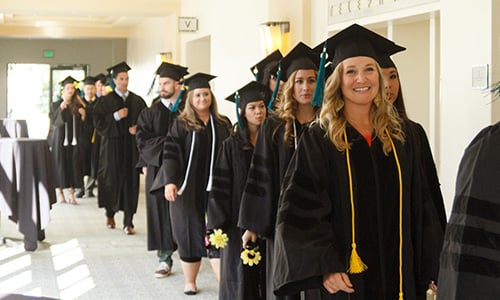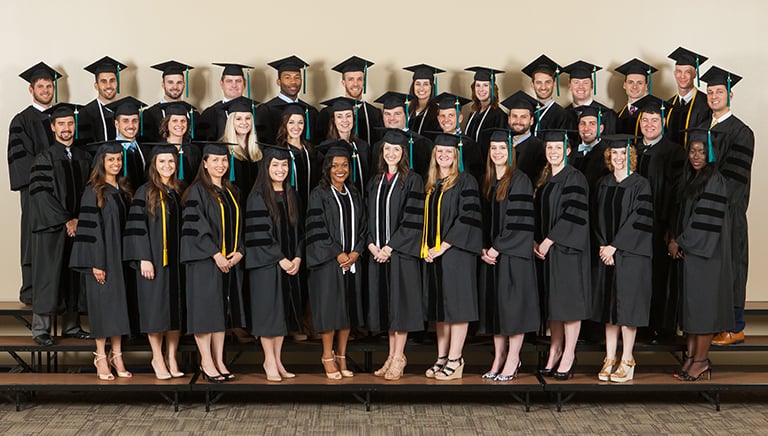
Becoming a licensed physical therapist (PT) is a huge milestone—but it’s just the beginning of your career. The best practitioners are always looking for opportunities for advancement in physical therapy. That’s what PTs do—they encourage their patients to move forward, one step at a time.
After earning your Doctor of Physical Therapy (DPT) and practicing in the field, there’s always another level of physical therapist career advancement. If you’re looking to broaden your skill set in physical therapy, there are several options.
In this comprehensive guide to advancement opportunities for a physical therapist, we’ll review how to further your physical therapy career.
1. Complete a Post-Professional Program Through the ABPTRFE
The American Board of Physical Therapy Residency & Fellowship Education (ABPTRFE) accredits PT residency and fellowship programs. Recognized by the American Physical Therapy Association (APTA), the agency sets the standards for post-professional physical therapy programs nationwide.
There are two paths of advancement opportunities for a physical therapist looking to further their skills in a clinical environment. Let’s consider each one.
Physical Therapist Advancement Opportunities During Residency
Many medical professionals engage in a residency program after graduation, and physical therapists have a similar prospect. In a PT residency, you’ll work one-on-one with a mentor in your specialty.
Residency programs are more than on-the-job experiences. These opportunities for advancement in physical therapy are an excellent way for PTs who have graduated from a physical therapy graduate program to apply their knowledge of evidence-based orthopaedic techniques within their workplace under the guidance of an onsite or virtual mentor. Throughout the process, you’ll complete coursework that you can apply in the clinic. USAHS offers a Clinical Orthopaedic Residency program designed to equip clinicians with superior post-professional clinical skills, advanced knowledge of clinical practice and the ability to serve as PT consultants, advocates and educators.
Physical Therapist Advancement Opportunities During a Fellowship
Designed for PTs who have already completed a residency, a fellowship advances their expertise to the next level. In these advancement opportunities for a physical therapist, you’ll further hone the specialized skills you explored in your residency.
ABPTRFE accredits fellowship programs in the following nine areas:1
- Critical Care
- Hand Therapy
- Neonatology
- Neurologic Movement Disorders
- Orthopaedic Manual Physical Therapy
- Performing Arts
- Spine
- Sports Division 1
- Upper Extremity Athlete
2. Become an ABPTS-Certified Specialist
The American Board of Physical Therapy Specialties (ABPTS) is another APTA-recognized organization that offers advancements in physical therapy to practitioners who undergo specialized training.
At the time of writing, there are ten specializations in which physical therapists can become certified that offer opportunities for advancement in the physical therapy field. You can choose from:
- Cardiovascular and pulmonary – Focus your practice on treatments that benefit a patient’s heart, veins and lungs.
- Clinical electrophysiology – As technology advances, so do the possibilities for physical therapists. A PT specializing in clinical electrophysiology uses devices to measure, analyze and produce physiologic responses in patients.
- Geriatrics – If you want to help clients maintain wellness as they age or regain function after strokes and other age-related conditions, geriatrics is an ideal choice.
- Neurology – In the in-demand neurology specialty, you’ll treat patients with various neurological disorders, injuries and impairments.
- Oncology – The field of oncologic physical therapy involves managing the needs of patients with cancer and related conditions.
- Orthopaedics – The most popular specialty, orthopaedics, focuses on treating injuries and conditions of the bone, muscle, tendons, ligaments and joints. Specialists also see patients with systemic musculoskeletal disorders such as arthritis, as well as those recovering from surgery.
- Pediatrics – Pediatric specialists focus on treating physical conditions in young people, from newborns to teenagers. They may see patients with conditions such as cerebral palsy, autism and cystic fibrosis.
- Sports – This specialization focuses on the prevention, treatment and rehabilitation of sports injuries from a physiological and psychological perspective.
- Women’s health – In this relatively new specialty, you’ll learn how to help women experiencing pregnancy, postpartum conditions, menopause and other health issues across a woman’s life span.
- Wound management – The newest specialty, wound management, encompasses both superficial and deep wounds with an emphasis on the relationships between body systems and how treating one system impacts another.
How to Earn a Specialty
If you’re hoping to become board-certified and explore physical therapist advancement opportunities in any of these areas, you’ll need to meet the requirements, which include:
- Experiential hours – Applicants need 2,000 hours of direct patient care in their chosen specialty area within the last ten years. They must have earned 500 of those hours in the past three years. Alternatively, you can show proof of attending an APTA-accredited postprofessional clinical residency within the past ten years in your specialty area.2
- An unrestricted license – You must hold a valid, unrestricted PT license that allows you to practice in the United States.
Along with these general requirements, each specialty area may also ask you to meet specific conditions.
Once you’ve satisfied the requirements for your chosen specialty area, you can apply through the APTA website.After your application is accepted, you can take your certification exam. If you study diligently, you should have no problem passing the exam and becoming a board-certified specialist in your area of PT.


3. Earn a Terminal Degree
Although the DPT is a doctoral degree, it’s an entry-level qualification. Some PTs wish to reach the pinnacle of education in their field through physical therapist advancement opportunities, such as earning a terminal degree like a Doctor of Education (EdD) or Doctor of Philosophy (PhD).
Learn More About Our DPT Programs
Doctor of Education (EdD) Degree
Many licensed physical therapists are motivated by the opportunity to help others. If your goal is to share the benefits of PT with as many people as possible, consider physical therapist advancement opportunities such as becoming a healthcare educator.
When you enroll in a Doctor of Education (EdD) program, you gain not only opportunities for advancement in physical therapy but also the skills you’ll need to instruct the next generation of PTs in the classroom or clinic. Each physical therapy student will eventually go on to help thousands of patients.
The time it takes to complete an EdD varies by program and institution. The Doctor of Education program at USAHS can be completed in as few as three years or less based on transfer credit and prior learning experience; however, the average time to degree is four years for students who have graduated within the last three years.* USAHS’ EdD program focuses on healthcare education, distinguishing it from other fields of education.
Doctor of Philosophy (PhD)
If research is your passion, a PhD offers advancement opportunities for a physical therapist. It allows you to delve into an area of PT research and thoroughly investigate it. The PhD is prime preparation for a career in academia, whereas the EdD is more broadly applicable within academia, clinics and other healthcare organizations.
4. Join an APTA Chapter or Section
To discover more physical therapist advancement opportunities, consider joining your local chapter of APTA.
Across all 50 states and the District of Columbia, APTA maintains chapters that host events and learning opportunities that advocate for physical therapists in local and state legislation.
Additionally, you’ll find APTA sections, also called academies, that offer courses, host conferences and publish scientific journals. By participating in these think tanks, you can help shape the future of healthcare in the United States—all while taking on opportunities for advancement in physical therapy.
Why Pursue Physical Therapy Advancement Opportunities?
If you’re content with your current role, there’s no need to pursue advancement opportunities for a physical therapist. However, if you’re considering climbing the clinical ladder, here are some advantages to consider.
Deepen Your Understanding of the Field
First and foremost, opportunities for advancement in physical therapy allow you to expand your passion for helping others. By furthering your education or pursuing a specialty, you open yourself up to exploring:
- Cutting-edge treatment strategies
- Research findings that shed new light on PT practice
- Technology that aids diagnosis and treatment
The better you understand the ever-changing field of physical therapy, the better you can help your patients. That in itself is a reward.
Attract More Patients
By pursuing opportunities for advancement in physical therapy, such as earning a certificate from an accredited residency or fellowship program, you can instill more trust in potential patients. For example, if an athlete has to choose between you and the other physical therapists in town, you can imagine they’ll want to pick the more qualified professional.
Increase Your Salary
By taking on more physical therapist advancement opportunities, you increase the potential for earning higher wages. For example, the salary for a practitioner with a Doctor of Physical Therapy degree will be higher than for positions requiring less education, such as physical therapist assistants and aides.3, 4 According to the U.S. Bureau of Labor Statistics (BLS), the median annual salary for PTs nationwide is $99,710.4
However, those with advanced qualifications can often command salaries above this median. Physical therapists in the top 10% of earners can make upwards of $130,870 per year.5 Now that’s what it means to move forward.
The largest PT school in the United States,** the University of St. Augustine for Health Sciences (USAHS) offers a hands-on Doctor of Physical Therapy (DPT) degree with scholarship opportunities available. Join a collaborative cohort of peers who learn under the mentorship of expert faculty-practitioners. Practice with mock and real patients in our state-of-the-art simulation centers and learn anatomy with our high-tech tools. Prepare for clinical practice with a wide range of patients, as well as for advanced roles in research, practice leadership and policymaking. Residential (blended didactic courses + in-person labs on weekdays) and Flex (online courses + in-person labs on weekends) per term formats are available.
Salary data may not reflect starting pay for recent graduates.
*The program can be completed in as few as three years or less depending on individual progress, traditional vs. accelerated pathway, credits transferred, prior learning experience, and other factors. The average time to degree is four years for students who have graduated within the last three years.
**Based on total DPT degrees conferred, as reported by the Integrated Postsecondary Education Data System (IPEDS). Data is captured by IPEDS through interrelated surveys conducted annually by the U.S. Department of Education’s National Center for Education Statistics (NCES). https://nces.ed.gov/ipeds/
Sources:
- American Board of Physical Therapy Residency and Fellowship Education, “For Physical Therapist Residency & Fellowship Participants or Prospective Participants,” ABPTRFE, 2024, https://abptrfe.apta.org/for-participants.
- American Physical Therapy Association, “Minimum Eligibility Requirements and General Information for All Physical Therapist Specialist Certification,” APTA, 2024, https://specialization.apta.org/become-a-specialist/minimum-requirements.
- U.S. Bureau of Labor Statistics, “Physical Therapist Assistants and Aides: Summary,” BLS, August 29, 2024, https://www.bls.gov/ooh/healthcare/physical-therapist-assistants-and-aides.htm.
- U.S. Bureau of Labor Statistics, “Physical Therapists: Summary,” BLS, August 29, 2024, https://www.bls.gov/ooh/healthcare/physical-therapists.htm.
- U.S. Bureau of Labor Statistics, “Physical Therapists: Pay,” BLS, August 29, 2024, https://www.bls.gov/ooh/healthcare/physical-therapists.htm#tab-5.








